Soil mixing techniques are used to mechanically blend soils in place with cementitious material to improve the soil engineering properties such as strength and compressibility. This installment discusses the soil mixing concept and technology.
Oftentimes the engineer has no influence over the location of the wind energy site and has to design the foundation around whatever geologic setting or soil types are found there. When faced with soft soils that are unsuitable for shallow foundations, the engineer often turns to deep foundation systems such as drilled shafts or driven piles. Deep foundations bypass unsuitable soils and bear into deeper strata to provide the required capacity. These foundation solutions can present challenges due to schedule constraints, cost, and constructability limitations. For many soft soil conditions, soil mixing techniques can produce columns or a stiffened mat of soil cement, often referred to as “soilcrete,” to support the proposed wind tower foundation. Shallow foundations can then be constructed on top of the soilcrete columns or soilcrete mat. Because mixed soil provides enhanced bearing capacity and reduced compressibility, the use of the soil mixing technique allows for a reduction in size of the mat foundation for the tower, often reducing the overall construction cost and time.

Soilcrete created by mechanical soil mixing introduces cementitious binder material into the soil through a hollow rotating pipe that is equipped with cutting and mixing blades. The soilcrete product can take the form of individual columns of various sizes, typically in the range of 2.5 to 8 feet in diameter. Columns can be installed as individual elements, as overlapping multiple elements installed with a multi-axis mixing tool, or in the form of a mat, installed with a specialized blending tool attached to an excavator arm. Depending on the equipment, treatment depths can exceed 80 feet.
There are two types of soil mixing: wet, and dry. For wet soil mixing the cementitious binder is introduced in slurry form, whereas cementitious binder is introduced in powder form for dry soil mixing. The appropriate method is chosen based on the moisture content of the targeted soils and the application (i.e. structural foundation support or slope stabilization).
For column-style soil mixing, individual columns or a grid pattern of overlapping columns are often installed to treat 15-70 percent of the targeted soil mass. The percentage of treatment is dependent on the existing soil conditions, design loading, and performance criteria. The relationship between the treated and untreated soil is often referred to as a geocomposite ground improvement system. This composite system is also affected by the strength of the installed soilcrete elements. When a mass mixed solution is used, nearly 100 percent of the targeted problem soils are treated to ensure compliance with the performance requirements of the foundation. Depending on the existing soil types, very large loads can be handled easily after soil mixing treatment.
Soil mixing is often chosen as a pre-construction ground improvement process, before installation of the tower footing. After soilcrete construction the site is graded and the mat foundation is constructed. Depending on the design requirements the mat can be installed just below grade to take advantage of overburden surcharge for overturning resistance, or built at grade. Either construction option would be acceptable and would more than likely be driven by the project economics. Anchors can be installed into the soilcrete elements to resist overturning.
The construction aspects of the soil mixing process and the need to carefully control the blending of the soil in place demand a rigorous quality control plan. Typically, computerized equipment is used during the installation process to monitor the quality of the constructed soilcrete. Samples are taken during the construction process of the wet soilcrete and are tested in accordance with applicable standards to ensure that the minimum design unconfined compressive strength (UCS) of the soilcrete is being achieved. Continuity testing of the constructed elements from top to bottom is also performed as a post-installation check of the quality of the constructed soilcrete.
Since its introduction in the early 1950s, soil mixing has increasingly been used to improve poor soil conditions worldwide. Soil mixing is fast becoming an economical and efficient alternative to deep foundations for challenging sites, particularly for wind turbine foundation applications.


































